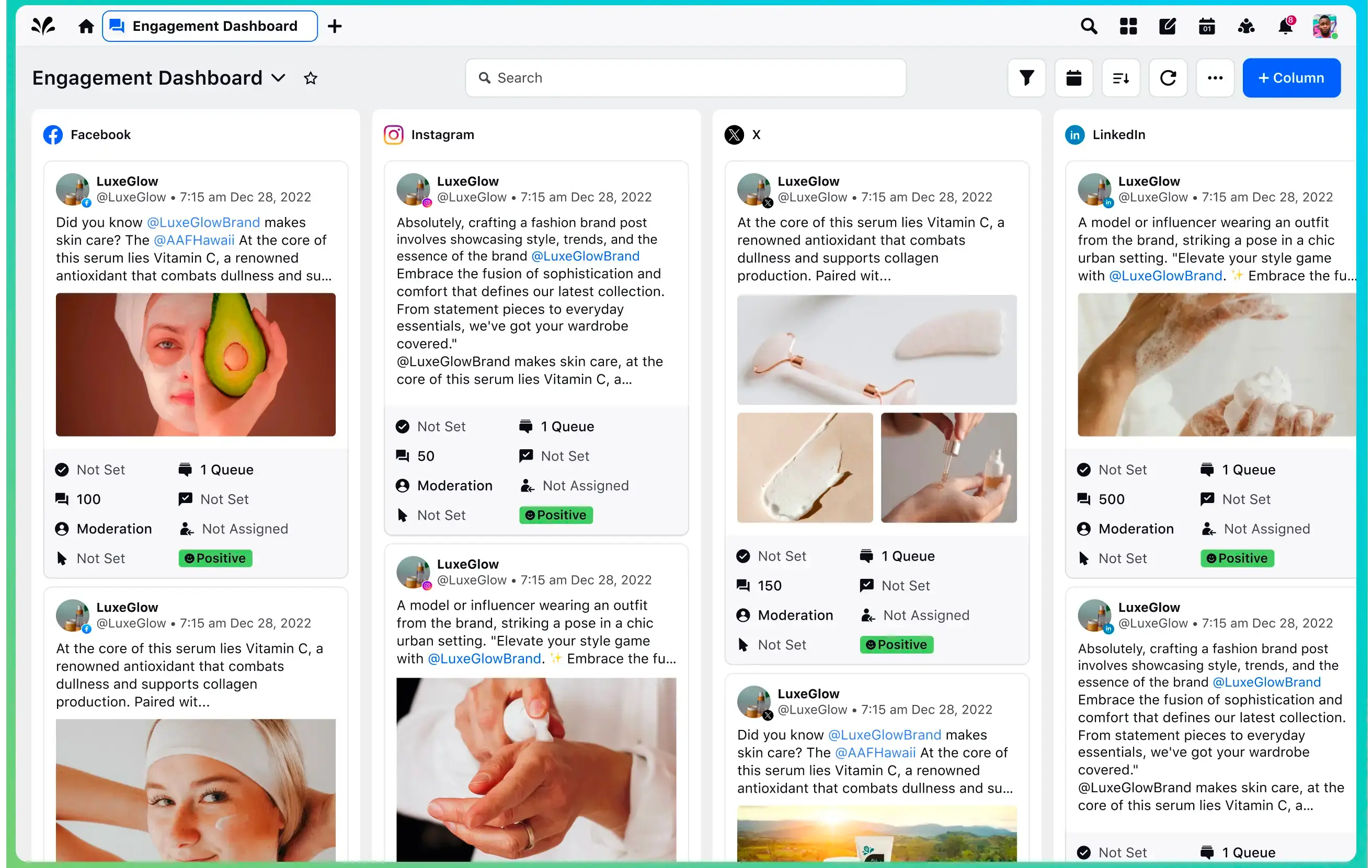The undisputed leader in social media management
For over a decade, the world’s largest enterprises have trusted Sprinklr Social for its in-depth listening, unmatched channel coverage, enterprise-grade configurability and industry-defining AI.

Social Media Policy for Business: The Complete Guide
Meet Tim — code whisperer, tech whiz and a newbie at a red-hot Silicon Valley startup. On a high after cracking a labyrinth of complex code for an upcoming, game-changing app feature, Tim snaps a cryptic screenshot and slaps it on Instagram.
Boom!
Likes, comments, speculation — his post goes mini-viral. But here's the twist: among his followers are eagle-eyed rival techies sniffing out an opportunity.
Fast forward to Monday. The company’s top brass catches wind of the not-so-innocent post. All of a sudden, their secret project stands threatened and their strategy is in jeopardy. Tim faces the music, the post gets deleted and the team scrambles to reconfigure their game plan.
This incident forces the startup to draft a stringent social media policy.
The reason? To prevent confidential information from casually slipping into the public domain and, potentially, into competitive hands.
This wake-up call hits home — protecting intel in this hyper-digital era isn't solely about cyber security but also entails curbing what employees share on social media. An overzealous post can unwittingly morph into a goldmine for rivals and hackers. Such gaffes highlight the critical need for an unwavering social media policy in today's tech landscape.
Now, you may be asking how this applies to you and your brand — that's precisely what we will address in this blog. No matter what industry you may be operating in and the size of your business, understanding and creating a tailored social media policy is a must.
In the following sections, we'll detail what a social media policy plan should contain and why it's a must-have for businesses navigating the digital realm.
- What is a social media policy?
- Why every company needs a social media policy for its employees
- Things to know before you draft a social media policy
- What needs to be included in a social media policy?
- The best practices for rolling out a social media policy
- Build internal collaboration
- Make it crystal clear
- Understand the boundaries between public display and confidentiality
- Ensure brand integrity
- Examples of social media policies from top brands
What is a social media policy?
A social media policy is simply the guidelines and rules a brand establishes to govern how its employees use social media platforms. It's an integral part of a brand's overall social media management.
In other words, how employees should conduct themselves on social channels. From sharing specific types of content to how they respond to customer comments (both positive and negative), a social media policy carries all the details of what can be shared and what cannot.
Remember when MySpace was a thing? That was when companies realized the power and reach of social media. Also, brands discovered both the potential and risks associated with social networks.
As social media transitioned from a user commodity into a crucial business tool, brands went, "We'd better get some ground rules in place here." And that’s when the concept of social media policy emerged to help brands navigate social media's exciting yet unpredictable waters. So when you talk about a social media policy, you have to consider it as a guideline that you put in place for your employees.
Why every company needs a social media policy for its employees
In today's digital age, where information spreads rapidly and public perception can make or break a business, having a social media policy is crucial for every company. Here's why you need to create your own social media policy today.
- Protect the brand: Employees are considered brand advocates. Thus, their online activities can directly impact the company's reputation. A social media policy helps ensure employees represent the brand positively and objectively.
- Mitigate legal risks: Employees sharing sensitive or confidential information online can result in legal issues such as data breaches or intellectual property violations. A well-crafted social media policy shields the company from potential legal risks.
- Maintain productivity: Excessive personal use of social media during work hours can hamper productivity. A clear policy on social media usage sets expectations and helps employees understand what is acceptable during working hours.
Things to know before you draft a social media policy
Before preparing your organization’s social media policy, consider the following:
- Consult legal professionals: Social media laws and regulations vary by country and industry. It's essential to consult legal professionals to ensure your policy complies with applicable laws and safeguards your business effectively.
- Balance freedom and restriction: Find a balance between empowering employees to use social media creatively and ensuring responsible usage that aligns with the company's values and objectives.
- Communicate clearly: Ensure the policy is written in clear and easily understandable language. Avoid using complicated jargon. Provide examples and scenarios to clarify expectations.
Learn more: How to create a social media strategy from scratch?
What needs to be included in a social media policy?
Imagine you're about to craft a social media policy — your playbook for the digital playground. It’s like cooking up a gourmet meal — you need the right ingredients in just the right amounts. So, what's the recipe for a foolproof social media policy? Let’s break it down into bite-sized bullet points.
Clear guidelines: This is the heart of your policy. For example, if you run a coffee shop, you'll want rules about photographing customers (hint: get their permission!). Defining the dos and don'ts regarding sharing client strategies or sneak peeks of upcoming campaigns is essential for a marketing agency.
Online etiquette: Lay down how your team should interact online on social media. Encourage them to be respectful, stay professional and not engage with online trolls.
Legal stuff: It may not be exciting, but it's vital. Your social media policy should detail intellectual property rights, privacy rules and FTC guidelines. For instance, a fitness center should establish a clear protocol regarding the use of copyrighted music in their workout reels.
Crisis management: Prepare for those turbulent internet moments. Determine who handles a social media crisis and establish protocols for responding to negative comments or reviews. It could be a bakery dealing with criticism for a batch of burnt buns or a law firm managing a disgruntled client's X, formerly Twitter rant.

The best practices for rolling out a social media policy
A well-written social media policy serves as a digital guidebook, preventing your brand’s social accounts from turning into the Wild West. It contains best practices on how your brand and employees should engage with people online, saving you from nasty legal troubles and PR nightmares.
Here are some handy tips for rolling out a social media policy for your organization.
Build internal collaboration
First, hold an initial "kickoff" meeting with representatives from each department — HR, legal, PR and marketing. This isn't just for the managers; involve team members who are on the front lines and understand the nitty-gritty of their relationship with social media. The goal is to ensure that everyone understands the purpose and significance of this endeavor, reducing resistance and getting more buy-ins. Consider creating a survey to gauge how your staff currently uses social media, their understanding of existing guidelines (if any) and any concerns they may have. Hold follow-up meetings to brainstorm, debate and piece together the policy. Encourage open communication. Remember, this policy affects everyone in the organization, so all voices must be heard. Next, assign roles based on each department's expertise.
- Legal: focus on compliance issues such as privacy, copyright and potential liabilities
- HR: address employee conduct during and outside work hours
- PR: the guardians of your company’s reputation, so they'll handle crisis management aspects of the policy
- Marketing: speak to proper brand representatives and create promotional guidelines keeping compliance in mind
After drafting the policy, share it with the core team for feedback before finalizing it. Remember, this is a living document and not something set in stone. As social media and your brand evolve, the policy will need to be revamped accordingly.
Make it crystal clear
Social media policy is about clarity, examples and eliminating the corporate jargon. Let's say you're the owner of a fantastic new pizza joint — let's call it "Pepe’s Pizza." You want your employees to engage with customers online while maintaining a professional image that aligns with your brand. How do you make that happen?
First things first, be clear about your expectations, avoid jargon, and communicate in plain and simple language that resonates with your team. Instead of saying, "All online engagements should reflect the brand ethos of Pepe’s Pizza," you could say something like: "When chatting with our wonderful patrons online, keep it friendly and professional, just like we do in the restaurant."
Now let's use real-life examples to bring these points home. Here’s one approach you could try.
Example - Positive: Let's say a customer leaves a rave review about your signature Mexican Pizza on your Facebook page. A great response might be, “Thanks a lot for your kind words, Jane! We're thrilled to hear you loved our pizza. Our in-house chef will be over the moon to hear this! Hope to see you back at Pepe’s Pizza soon!"
Example - Negative: On the flip side, if a customer posts a negative or a not-so-good review about a delayed order, you might respond, “Hi John, we're sorry to hear about your experience. It's not the standard we aim for at Pepe’s Pizza. Please send us a private message with your order details so we can make this right."
Provide similar examples for different situations and platforms. Be sure also to cover what NOT to do. For instance, you might say, "If you encounter a negative comment or review, never argue or post disrespectful comments. Instead, remain calm, polite and seek to resolve the issue professionally."
Understand the boundaries between public display and confidentiality
Think of social media platforms as giant billboards. Everyone who’s driving around or walking can see what’s on display. And that’s how public your social media posts can get, whether on X, formerly Twitter or LinkedIn. Anyone with internet access can view your comments, shared posts and more. So, it’s essential to understand the distinction between public and private information, especially in this politically correct world, where everyone is waiting for an opportunity to criticize you.
For instance, team outings, birthday celebrations and casual team snapshots without sensitive data are great to share. They reveal the company culture and attract new talent. However, things like financial reports, engagement data, client logos, etc., should always stay in your system and should stay in-house. As a rule of thumb, your information on social media shouldn’t benefit your competitor in any way. Or if you anticipate a post being trolled or facing backlash, it’s best not to share it on any social media platform, regardless of the value of the information. Lastly, It’s beneficial to have a committee or even one designated team responsible for reviewing the content before it is published on social media as a safeguard measure.
Ensure brand integrity
Clarify that violations of your policy can have serious consequences. This should not create an atmosphere of fear but rather protect your brand's integrity. Also, ensure everyone knows what social media behavior is acceptable and what isn’t. Regular training sessions will ensure everyone stays up-to-date on current trends and legal developments affecting privacy and integrity on social platforms.
With these best practices in mind, you're all set to make an impact on social media while maintaining the integrity of your brand’s reputation.
Examples of social media policies from top brands
Creating easy-to-follow and relatable social media policies is easier said than done. Ask any brand today, and they will tell you how much effort goes into making these policies. Some brands, however, have found the secret to creating near-perfect social media policies. Let's check out three examples of brands that have nailed their social media policies, balancing the brand’s needs while demonstrating empathy.
Top tech company’s 'Three Simple Rules' policy
A leading American multinational tech company was among the pioneers in establishing a social media policy. You may expect such a policy from a large tech giant to be filled with complex jargon. However, this brand surprised everyone by keeping its social media policies simple and easily understandable for every employee. The brand categorized its social media rules into three clear buckets: disclose, protect and use common sense. Firstly, employees were instructed to disclose their affiliation with the company. Secondly, they were mandated to handle sensitive information responsibly and exercise caution while sharing even the most minor details online. Lastly, the brand communicated its social media policy in a clear and straightforward manner, avoiding corporate jargon.
Leading beverage company’s 'Online Spokespeople' policy
This top beverage brand empowered employees to become its "online spokespeople." It is a rare approach in a world where brands often rely on influencers as their representatives. Instead of discouraging employees from sharing their experiences, the brand encouraged them to do so openly. It gave each team member a metaphorical megaphone, promoting the idea of speaking loudly and proudly when they have something positive to say. However, the brand also emphasized that personal views remain personal and may not always align with the company's standpoint. Additionally, any confidential information that could potentially harm the brand had to stay confidential.
Popular German apparel and sporting goods brand’s 'Play Fair' policy
This renowned apparel brand adopted a refreshingly relaxed approach to its social media policy. It cleverly aligned its guidelines with a game of soccer, a sport deeply embedded in its DNA. The company emphasized the importance of employees openly acknowledging their affiliation with the brand, safeguarding company secrets and playing fair by respecting copyright and other laws. It effectively reminded everyone to act responsibly and exhibit true sportsmanship without bending the rules. Isn’t this a creative and enjoyable way to promote responsible participation on social media?
Each of these companies implemented social media policies that were compassionate and inclusive, recognizing their employees as individuals navigating a constantly changing online landscape. And that's the key to crafting guidelines your employees genuinely desire to adhere to!
Final thoughts
In the expansive realm of the digital landscape, your employees must navigate social media cautiously. Tim's cautionary tale is a powerful reminder that a single social media post can trigger a storm of risks and legal consequences. It is a wake-up call underscoring the significance of establishing more robust social media policies. By formulating well-crafted guidelines, you not only protect your brand reputation but also shield your employees from legal pitfalls and potential job loss.

